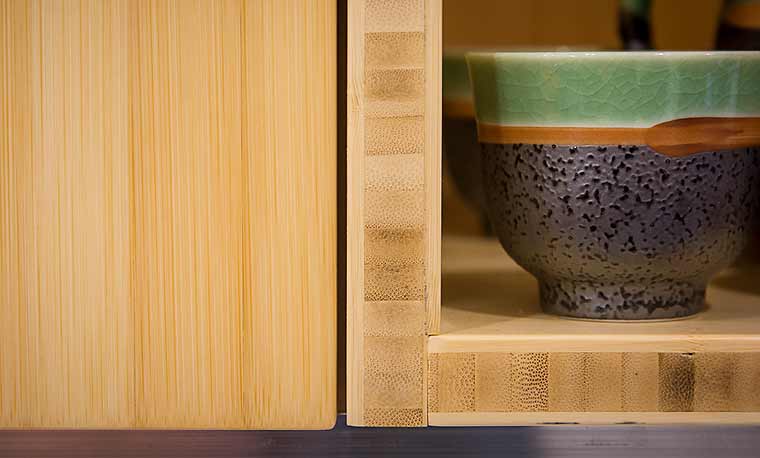This week’s blog topic is “Sustainability.” But don’t worry, you won’t be reading a preachy post about how you should switch out your light bulbs, raise chickens in your backyard, and turn off your air conditioner. I’ve written those already. And while I often look for ways to live a more sustainable lifestyle (which may include backyard chickens this year), I often have trouble following my own advice!
So I hereby promise that’s the last time I’m going to use the word “sustainability” in this article.
It’s a buzzword that I often find myself turning to as a shortcut in conversation. Yet, it has become far too broad a term to have much meaning at all. Instead, let’s talk about specific ways we at Silent Rivers view our roles as responsible stewards of our clients’ homes.

Responsible stewardship of our clients’ homes can mean many things. The custom cabinets we designed for this major kitchen remodel were made from bamboo plywood, a rapidly renewable resource.
Thoughtful Design
The design process sets up a structure through which we make important decisions about balancing project scope, use of space, budget, aesthetics, materials, and construction detail. At the start of the design process we work with clients to define and refine their underlying goals for the project.
For example, “the kitchen is too small,” is a common starting point for a remodeling conversation. From that, building an addition might seem to be the obvious solution. But, before defaulting by adding square footage, Silent Rivers first helps our clients envision how they will use their new kitchen. We might discover that “more space” alone won’t adequately resolve their specific needs for two work areas, a better connection to the dining room, and a good view of the swing set in the backyard. Instead, through creative brainstorming and working with experienced designers, it is often possible to arrive at solutions that utilize the existing space. Working within the existing footprint of the home has many benefits related to energy conservation and environmental impact.
Resource Management
Each of the materials we remove as part of a remodeling project has an environmental and economic cost. The raw materials for the plaster on your ceiling had to be mined, manufactured, transported, mixed, installed, and maintained. When we tear it out there is a cost for labor, transportation, and disposal. Responsible stewardship of our clients’ homes (and of their investment) involves taking those costs into consideration and looking for ways to reduce the impact. Sometimes achieving that involves recycling or donating demolition material. Other times, we will look for ways to reduce the amount of material that is necessary to remove.
On the flip side, the materials we install as part of the construction also have a cost. This is where craft and durability enter into the calculation. There is an undeniable tension between these and construction cost. More durable materials and higher levels of craftsmanship, by definition, involve a higher upfront investment, but these pay back over the long term. We balance this equation differently for each project and each client, but the underlying discussion is important.
Energy Efficiency
Good stewardship of our clients’ homes also involves careful consideration of energy consumption and indoor air quality. Renovation projects for kitchens, family rooms, and bathrooms often involve increasing the number of light fixtures, outlets, and appliances. Additions and major rehabilitations often necessitate the upgrading of insulation and furnaces. According to the US Department of Energy, heating and cooling make up the largest percentage of residential energy use. However, appliance, lighting, and electronics are quickly gaining using 34% of that energy!
As we take the long view, it is important to recognize that maintenance and energy costs eclipse the initial investment to purchase and install a new appliance, furnace, or fixture. The less energy these use, the lower that lifecycle cost will be.
Of course, electrical and heating and cooling systems are extraordinarily complex. Because these systems are interrelated, a simple change to one may result in positive or negative consequences throughout the house. For example, air sealing and insulation upgrades are great solutions to increasing a home’s overall energy efficiency. However, a well-sealed house leaves no place for humidity to escape and can result in an uncomfortable interior climate. Silent Rivers takes a systems approach to these types of improvements and maintains a constant emphasis on continuing education for our designers and field staff.
Big Picture
So now, perhaps, it is possible to tie these ideas back in to the bigger picture. What if every builder and remodeling contractor placed a priority on thoughtful design and quality craftsmanship? What if every homeowner asked their contractor for better waste management practices and demanded a higher rate of recycling or re-purposing of used materials? What if we could achieve just a 20% improvement on energy efficiency in all homes through better air sealing and insulation?
There is no question that if these steps were taken by all of us, collectively we would make a huge impact on sustainability.
Oh well. I almost made it to the end without breaking my promise.
As an outstanding example of Silent Rivers’ comprehensive sustainable renovation expertise, see our Green & Main Pilot Project. Our designers and construction team have taken this historic Sherman Hills mixed-use building from abandoned to a nearly complete, stunning sustainable renovation! The transformation of this old neighborhood grocery store is an amazing story, and it helps to position Des Moines as a leader in historical sustainable renovation.
Ongoing education is a hallmark of Silent Rivers Design+Build, ensuring our designers artisans are always mindful of ways to make your home healthier, more energy efficient and in better balance with its environment. Visit our Services & Expertise page to learn more about our specialties and see project examples.